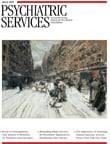Traumatic events are ubiquitous in everyday life, from motor vehicle accidents to assaults and from natural disasters to war. Among people with serious mental illness, rates of posttraumatic stress disorder (PTSD) are as high as 45%. Why is it so difficult for clinicians to routinely assess for exposure to trauma and for PTSD? The brief report by Posner and colleagues in this issue offers a unique lens through which to see this problem. Repeating a study done ten years ago in a New York clinic, these authors found that even though there was some improvement, only 50% of patients' charts included an assessment of exposure to a traumatic event. Of these, only 50%–60% included an adequate description of the severity and frequency of the trauma. PTSD symptoms were assessed for only 35% of the patients with a positive trauma history.
What is wrong with this picture? We know that traumatic events are an "environmental" risk factor for PTSD and that the severity of the trauma is the best predictor of PTSD risk. Clinicians increasingly focus on gene-environment interactions, and PTSD is a leading area for investigation. Event-related disorders are not limited to PTSD. By examining the interactions of environment, genetics, and individual history, we gain deeper insight into the onset of depression and adjustment disorder and into the precipitants of major disorders such as schizophrenia. We need much better documentation of the environmental exposures of our patients—perhaps most importantly their exposure to trauma.
Our hospitals have not yet begun this task. Indeed, not until every patient in a trauma center has a psychiatric assessment as part of his or her admission will we be where we need to be. We know that the incidence of PTSD is about 35% after serious motor vehicle accidents, but most trauma centers do not require psychiatric assessment as part of medical care. In addition, most patients receive their psychiatric care in the primary care setting. However, many constraints prevent provision of trauma-informed primary care, including training, time, and incentives.
Posner and colleagues draw our attention to the need to address health care services and medical record keeping for PTSD (and environmental risk factors in general) in training programs, in our collaboration with medical colleagues, and in health care services in clinics and hospitals. As we learn more about traumatic events and psychiatric disease—and, more generally, about event-related disorders and the science of gene-environment interaction—we can advance the care of our patients and the science behind our treatments. Accurate patient assessment and medical record keeping is a critical component of this process.

